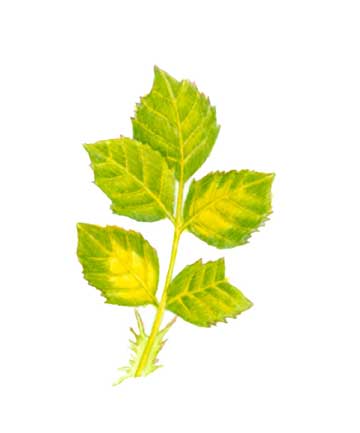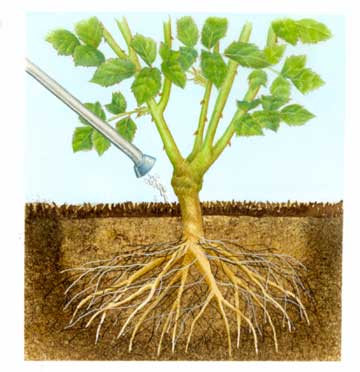





 Overwatered plants turn yellowand lose their leaves.
Overwatered plants turn yellowand lose their leaves.
Water is vital in delivering nutrients to the plant. It travels up the canes (depositing nutrients for new stem and flower growth), and down (to build a stronger network of roots). The circulatory system of the rose is not immune from challenges. Chief among them is the loss of water from pores in the leaves. This process is called transpiration, and when underwatered roots can't keep up with the watering needs of the plant, it wilts. Overwatering, on the other hand, starves the roots of oxygen, and the lower leaves turn yellow and fall off.
Click here for a list of top 10 fragrant roses.
continue reading below1. Give your roses 1 to 2 inches of water each week -- in single watering session -- from early spring through fall. Increase the frequency to every three or four days in hot and dry weather. Porous soils will also benefit from additional deep soakings.
2. Soak the soil to a 16- to 18-inch depth; light sprinkling does more harm than not watering at all, because the roots will not grow deeply enough to support the plant. Lightly watered plants are more easily injured by cultivation and they are also more prone to fertilizer burn.
 A watering wand is a good way to
get water to the roots.
A watering wand is a good way to
get water to the roots.
1. Check the depth of your watering to make sure it's reaching the roots. Water for a measured length of time and dig near the roots. If the soil is moist to a level of only 8 inches, you should water twice as long.
2. There are several options when it comes to choosing the method of applying water. Your choice will depend on your location, the size of your garden, the need for water conservation, and other factors. Among your choices are drip irrigation, underground sprinklers, or hand watering. Drip or low-volume irrigation is an efficient method that releases water to your plant without runoff. You can place an emitter on each side of your rose, use manufactured drip collars, or fashion your own with perforated drip tubing. Conventional spray heads direct water up onto the foliage, removing spider mites, which live on the underside of the leaves. Low volume mini-sprays apply water more economically, but don't do as good a job in wetting the foliage.
3. If you're hand watering, you may want to consider using a bubbler attachment. By flooding a basin around the rose, it allows water to soak slowly into the soil, and prevents a strong stream from eroding the soil or splashing dirt and mulch up onto the foliage. (Bubbler heads attached to underground systems accomplish this task even more conveniently.) Apply a 2- to 4-inch layer of mulch on top of the soil in order to slow the evaporation of water from the soil. Mulching also insulates the ground in winter so it freezes and thaws gradually, which prevents plants from "heaving."
1. Give more attention to roses grown in containers than those grown directly in the garden because they have less soil from which to draw moisture.
2. Check the moisture depth in the pot at least every one or two days during the summer -- every day when the weather is hot or windy. Unglazed pots lose moisture to the air more quickly than those made of plastic or glazed pottery. You can also put one container inside another to reduce moisture loss, but be sure the outside container has drainage holes, too.
Copyright © www.100flowers.win Botanic Garden All Rights Reserved